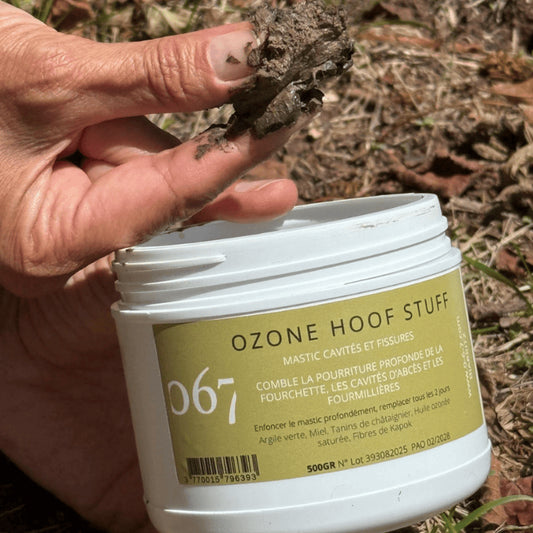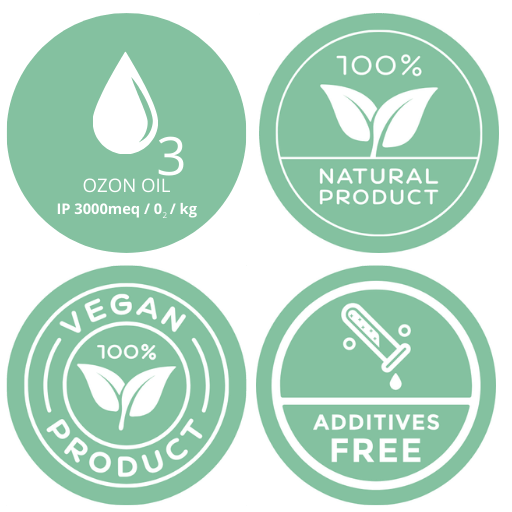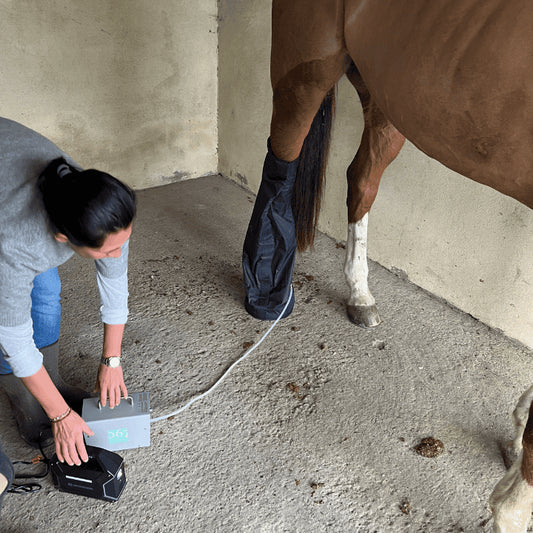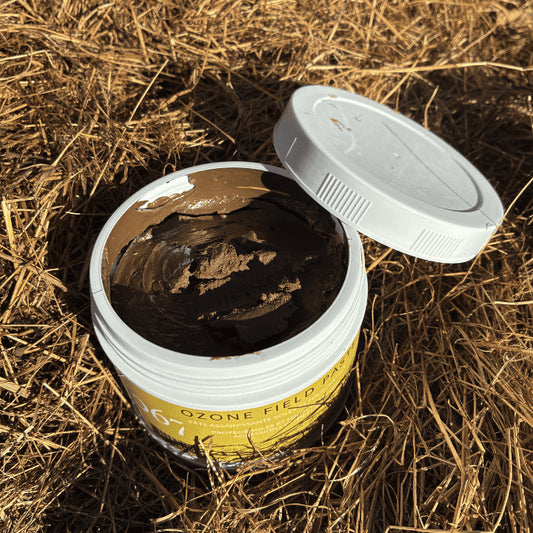
Over 1000 satisfied customers
5.0 Excellent
Natural horse care
OZONE HORSES | 100% Natural Horse Care
Foot and hoof care | Horse care
HORSE TOAD
ROTTEN FORK
MUD FEVER
LYMPHODEMA
Horse hoof care, treatment and care of the horse's frog, horn regenerator and care.




Skin care | Horse care
SUMMER DERMATITIS
CREVASES
IRRITATIONS
ROTTEN FORK
DAMAGED HORN
Natural equine skincare products. Treatments and care, ozone therapy for horses for all dermatological conditions. Horse care products made in France.



Wound care and healing | Horse care
WOUNDS
SARCOIDS
Treatment and healing of wounds and sarcoids. Horse care Made in France


Horse Care FAQs
Horse foot and hoof care
Horse skin problems
Horse wounds and healing
Why do horses' hooves get damaged so often?
Hooves are in constant contact with moisture, bacteria, fungi, and soil variations. An imbalance in the flora or a weakness in the hoof (loose soil, damp bedding, unsuitable shoeing) can cause deep infections such as thrush , canker sores , or abscesses .
Ozone treatments for horses allow these areas to be thoroughly sanitized without damaging the horn or disrupting the natural balance of the foot .
What is ozonated oil and why is it effective on hooves?
Ozonated oil is a vegetable oil saturated with ozone (O₃) . This natural horse care process creates ozonides, active molecules capable of oxygenating tissues, eliminating pathogens, and stimulating cell regeneration.
When applied to the hoof , it acts as a natural antiseptic, anti-inflammatory and healing agent, without microbial resistance or side effects.
What is the difference between Ozone Hoof Guard, Hoof Fluid and Hoof Stuff?
- Ozone Hoof Guard : liquid ozonated oil , used to sanitize infected frogs , bulbs or fissures .
- Hoof Fluid : a fluid based on chestnut tannins, ideal for prevention or for maintaining a healthy and dry foot .
- Hoof Stuff : a filler paste enriched with tannins and ozone, perfect for filling and disinfecting cavities (frogs, cracks , deep gaps).
- These three products can be used in synergy depending on the stage of the lesion.
How to recognize a rotten fork?
Thrush is characterized by a strong odor, black or soft material in the sulci, and sometimes pain upon pressure.
It indicates an anaerobic bacterial infection. Ozonated oil is a natural horse treatment that provides active oxygen, which destroys these bacteria and stimulates the regeneration of keratinized tissues.
What to do in case of a toadstool infection (deep infection of the foot)?
Toadstool is a serious and often chronic condition of the foot . It results from a deep infection.
( glomes , perioples , frog ) which goes up towards the top of the hoof .
The treatment must combine:
• deep cleaning by bagging with gaseous ozone,
• daily application of ozonated oil (Ozone Hoof Guard),
• filling with a tannin-based putty (Hoof Stuff).
This approach promotes the removal of exudates and the gradual regeneration of the foot.
Can ozone replace antibiotics in foot care?
Yes, in many cases. Ozone is a powerful oxidant that eliminates bacteria, fungi, and viruses without creating resistance.
Unlike antibiotics , it acts locally, without systemic effects or disruption of the flora.
It therefore makes it possible to reduce or even eliminate the use of topical antibiotics in the majority of foot conditions .
How to use ozone bagging on an affected foot?
The patented Bagging 067 device diffuses gaseous ozone directly onto the foot :
1. Place your foot in the boot.
2. Close tightly.
3. Diffuse the ozone for 20 to 30 minutes.
4. Next apply the appropriate ozonated oil (Ozone Hoof Guard or Mud Guard).
Treatment is carried out daily or every two days depending on the severity, until complete clearance.
Are ozone treatments compatible with horseshoes?
Yes, provided that the areas to be treated remain accessible (frog, bulbs, gaps).
Ozone penetrates the tissues and acts even deep down, including under the hoof wall. However, it is best to remove the shoe in cases of severe or severe infections to allow for better ventilation and thorough cleaning.
Can ozonated oils be used for prevention?
Absolutely. When applied weekly, they maintain the balance of the flora and prevent bacterial proliferation.
A few drops of Ozone Hoof Guard or Hoof Fluid on the clean frog are enough to keep a foot healthy , especially in wet weather or when changing bedding.
What is the difference between ozone-based treatments and those using Norwegian tar?
Tar works by isolating the fork from moisture, but it does not treat the existing infection.
Ozonated oils , on the other hand, provide deep healing thanks to their oxidizing and repairing action, while respecting the breathability of the hoof .
They therefore constitute a modern, natural and more physiological alternative to horse care .
How long does it take to see results?
The first signs of improvement often appear in 3 to 4 days: disappearance of odors, firmer tissues, beginning of healthy regrowth.
However, for deep-seated conditions ( toad , necrotic frog ), several weeks of regular care are required until complete regeneration.
Can ozone therapy be combined with other treatments?
Yes, ozonated oils work very well with treatments based on tannins, clay, honey or natural fibers, according to protocol 067.
They enhance the cleansing action of these ingredients while promoting faster healing and lasting regeneration of the horn.
They are genuine, effective, natural animal products made in France.
However, it is not recommended to use other products when starting an ozone-based treatment protocol.
Why do horses often have skin problems?
A horse's skin is thin, highly vascularized and often subjected to external aggressions: humidity, insects, perspiration, mud, friction or unsuitable products.
These factors weaken the skin barrier and promote the appearance of scabs , itching or infections .
What are the most common skin problems in horses?
The most common ones are:
• mud fever (limbs),
• summer dermatitis (mane and tail),
• chafing sores (halter, girth, blankets),
• fungal infections or pyoderma ,
• allergic reactions ( eczema , hives ).
Ozonated oils 067 act effectively on all of these conditions.
What exactly is mud fever?
Mud fever is a bacterial or fungal dermatitis caused by persistent moisture. It causes scabs, cracks, and sometimes swelling of the limb.
Ozonated oils (like Ozone Mud Guard ) help to cleanse the skin without irritating or drying it out, promoting natural and rapid healing.
What is the difference between mud fever, dermatitis, and eczema?
These conditions all manifest as skin inflammation , but their causes differ:
• Mud fever → bacterial (often Dermatophilus congolensis).
• Dermatitis → irritation or allergic reaction.
• Eczema → an inflammatory disorder that is often chronic.
Natural animal treatments based on ozone are adapted to each individual by regulating inflammation and rebalancing the skin flora.
Can ozonated oil replace topical antibiotics?
Yes, in most cases.
Ozone has bactericidal , fungicidal and virucidal action without side effects or resistance. It destroys pathogens while promoting healing and cell renewal .
Why is ozone so effective on a horse's skin?
Because it delivers active oxygen directly to the injured area.
It eliminates anaerobic microorganisms, stimulates microcirculation and accelerates cell regeneration .
It is a natural, powerful alternative that respects the physiology of the horse .
Should you mow or wash before applying an ozone treatment?
No, mowing is not recommended.
Simply trim the hair if necessary, brush gently and apply the treatment directly.
Ozonated oils penetrate better on slightly damp skin and do not require prior disinfection: they do everything.
Which 067 products should be used on skin conditions?
• Ozone Super Guard: initial, antiseptic and healing phase.
• Ozone Mud Guard: repair and remediation phase.
• Ozone Skin Guard: inflamed areas with itching .
These natural horse care products cover all stages, from disinfection to regeneration .
Can ozone treatments be used on sensitive areas (stomach, head, corners of the lips)?
Yes, absolutely, you can use our natural horse care products .
067 ozonated oils are 100% natural, without preservatives, alcohol, or perfume.
They can be applied to all areas of the horse , even the most delicate or irritated.
Does ozone help against summer dermatitis?
Yes. Ozone acts on both skin lesions and the local inflammation that causes itching .
Combined with restorative plant oils (such as sweet almond oil in Ozone Mud Guard ), it soothes, repairs and limits relapses.
What should you do when a horse's skin has thick scabs?
Never scratch or pick at the scabs.
Apply the ozone treatment directly onto it: the active oxygen acts under the scab, which will detach on its own once the skin has regenerated.
Is ozone suitable for horses with sensitive or allergic skin?
Yes, it's actually the best option.
Ozonated 067 oils are hypoallergenic and contain no irritants.
They restore the barrier function of the horse's skin and reduce inflammatory reactions.
Can ozone treatments be combined with other products (clay, tannins, honey)?
Yes, these associations are even complementary.
Chestnut tannins tighten tissues and protect, clay drains, honey nourishes, and ozone disinfects.
Natural horse care protocols 067 often incorporate these natural synergies, but it is not recommended to combine them with other treatments.
Can ozone therapy prevent recurrences?
Yes, regular application of Ozone Skin Guard or Ozone Mud Guard strengthens skin resistance and prevents the reappearance of germs.
Ozone maintains the natural balance of the horse's skin , even in humid or hot weather.
How long does it take to see an improvement?
The first positive signs (soothing, softer skin, reduction of scabs) after using our natural horse products often appear in 2 to 3 days.
Deeper conditions require daily care over several weeks for complete regeneration.
Why do horse wounds often heal poorly?
A horse's skin is thin and prone to muscle tension and movement. Furthermore, wounds are often contaminated by dirt, dust, or insects.
Ozone-based treatments promote clean, rapid healing without superinfection, even in the absence of antibiotics.
How does ozone help with healing?
Ozone acts on three levels:
• Immediate disinfection (bacteria, fungi, viruses),
• Stimulation of microcirculation and oxygen supply,
• Activation of cellular regeneration .
Ozonated oil thus provides everything the skin needs to close a wound
naturally.
Is it necessary to disinfect before applying ozonated oil?
No. Ozone completely replaces conventional disinfectants (Betadine, chlorhexidine, alcohol…).
Apply the oil directly to a clean wound (possibly rinsed with clean water).
It acts as an antiseptic, anti-inflammatory and healing agent.
Which ozonated oil should be used depending on the stage of the wound?
• Ozone Super Guard : initial phase (open, oozing, or infected wound).
• Ozone Mud Guard : repair phase (scabs, dry skin, hair regrowth).
The transition from one to the other occurs when the wound is cleansed and begins to close.
Can ozonated oil be used on a deep or infected wound?
Yes, that's actually one of its main indications.
Ozonated oil penetrates the tissues, oxygenates the area and neutralizes anaerobic germs responsible for abscesses and necrosis.
This prevents superinfection and accelerates natural regeneration.
Should the wound be covered after application?
Not systematically.
In well-ventilated areas, it is best to let the skin breathe.
On the other hand, for areas exposed to mud or insects, light protection (dressing, breathable bandage or natural film) may be useful for the first 24 to 48 hours.
Are ozone treatments suitable for old wounds or wounds that do not close?
Yes. Ozone reactivates healing even on old or fibrous wounds by boosting microcirculation and eliminating dead tissue.
Many horses regain supple skin without visible scarring after a few weeks.
How to treat sores at the corners of the lips or around the mouth?
These wounds are common due to bits or friction.
Ozone Super Guard oil is applied in a very thin layer, even on mucous membranes.
It promotes rapid healing without stinging or irritating, unlike chemical disinfectants.
Can ozonated oils be applied to wounds under the hair?
Yes. Shaving is not necessary.
Ozonated oil penetrates between the hairs to the skin and acts locally.
In the case of very dense hairs, you can simply part them with the cannula of the bottle to target the wound.
How long does it take to see an improvement?
In most cases, a clear improvement is visible within 3 to 5 days:
• reduction of seepage,
• clean scabs,
• pinkish skin,
• beginning of hair regrowth.
Daily application is recommended until complete healing.
Can ozonated oil be used on wounds near tendons or joints?
Yes, it can be applied around sensitive areas without risk.
Ozone acts on the surface and deep within the body, but without systemic absorption.
It promotes tissue repair while reducing local inflammation.
Are ozone-based products safe for long-term use?
Yes.
Ozonated oils are stable, non-toxic and perfectly biocompatible.
They can be used daily for several weeks without damaging the skin or
cause irritation.

















